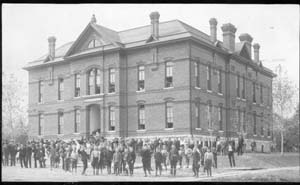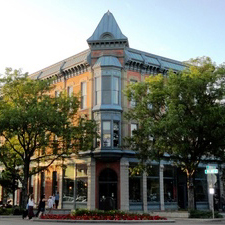News Flashbacks
Relive Memories of 70 Years:
Mr. and Mrs. Charles McKibben Remember Fort Collins As It Was Back In The 1880s
Article by Betty Woodworth
Fort Collins Coloradoan, article only dated "1950s"

Fort Collins of the 1880s--a thriving western town of about 1,200 inhabitants who still had to share their streets occasionally with wandering livestock-was recalled for this Coloradoan reporter in an interview with two of the city's present residents who were among the 1,200 seven decades ago. Mr. and Mrs. Charles McKibben of 1212 West Oak Street recounted some of their memories after calling the Coloradoan to correct an error in an article about the city's first cemeteries. Fort Collins' first cemetery, in which Camp Collins soldiers were buried, was directly in front of the present St. Luke's Episcopal Church rather than at the southwest corner of Oak Street and College Avenue, Mrs. McKibben explained. At the time the cemetery was used South College extended only through the 100 block.
A second block could not be built until the cemetery was moved. Mrs. McKibben's father, James C. Loomis, supervised the removal of the soldiers' bodies to Mountain Home cemetery in the southeastern part of the city, as a member of the City Council. Mrs. McKibben, who was born here in 1880, often heard her father describe the moving of the old cemetery. Later when Grandview cemetery was opened, bodies were moved there from Mountain Home. Mrs. McKibben's aunt, Mrs. John McPherson, was the first person to be buried there. The city policy on cemeteries was a subject of controversy when Grandview was opened also, she recalls. Many families complained that bodies moved from Mountain Home were given just half a lot in the new cemetery. The source of the town's water in the late 1880s was the ditch out West Magnolia Street , which ran in front of the Loomis home. Its' purity was considered doubtful.
Electricity and telephone service weren't just doubtful in the days the McKibbens first remember here; they were non-existent. There were no street lights of any kind then. The first light plant, Mrs. McKibben said, was built for William Miner, probably in the early 1900s, at the present location of the Toliver & Kinney Mercantile Co. The first telephone was installed in the courthouse, which was built in 1887. Today's residents would find themselves in an entirely strange environment if they could turn the clock back 70 years. Cattails grew where the Poudre Valley National Bank now stands and only a few shanties filled the 100 block of South College Avenue. In the business section with Jefferson and Linden Streets as the main thoroughfares, residents could deposit their money in the Yount Bank, which stood across from the Stover drugstore at Jefferson and Linden Streets. They got their mail first at the post office at Linden and East Mountain Avenue. Later the post office was moved to a building where the City Hall now stands. Mr. McKibben remembers Frank Stover's building vividly, because he was in the bucket brigade that tried unsuccessfuly to save it when it caught fire. Other early landmarks destroyed by another fire were the C. R. Welch store and a hotel which stood near the present site of the Woolworth store
The number of saloons in the early settlement has been exaggerated, the McKibbens say. They remember that there were seven. The Franklin School was brand new in 1887, as was the courthouse. The First Methodist Church of those days, the couple said, was on East Mountain Avenue. Those attending services had to cross planks over a swampy section in front of the door. One of the events of the late 1880s was Fort Collins' only lynching. The murderer which led to the mob action was witnessed by Mrs. McKibben's uncle, John McPherson. Mr. McPherson saw James H. Howe stab his wife with a pocket knife as she tried to run out of their home on Walnut Street. Howe had come home, his anger increased by drink, when his wife was packing to leave. Mrs. McKibben's mother came to the United States from Scotland at the age of 14 with her brother-in-law and sister, Mr. and Mrs. John Nelson Sr., and her brother, John McPherson. Going first to Chicago, they were there when fire nearly destroyed the city in 1871. They arrived in Fort Collins in the next year. One son Alex Nelson, who was born on Chicago's State Street, now one of the main business areas, lives at 713 Matthews Street.
The travelers came here from Chicago by train. When the Nelsons settled on a ranch three miles south of town, their niece said, there were no trees near their home, only prairie stretching in all directions. Mr. Loomis, who came to Colorado in 1872 from Coldwater, Mich., for his health, settled first at Longmont. Because he thought that being outdoors would improve his health, he drove a stage between Longmont and Cheyenne for a time. Mr. McKibben came here as a boy from Parkersburg, W. Va. Traveling by covered wagon, the party interrupted its' journey for two years in Missouri. The McKibben family lot at 511 Whedbee Street was bought for $65, Mr. McKibben said, and taxes on it were $8 a year. As a boy McKibben helped his father make bricks for the courthouse and the Franklin School. Later, as a contractor, Charles McKibben built the county garage and many other local buildings. He also erected Wellington's first chimney, for the Gould Lumber Company.


Preserving the history of Fort Collins, Colorado & the Cache la Poudre region





